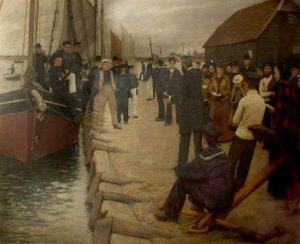By Professor Sumita Mukherjee, Dr Florian Stadtler, Dr Aleena Din, Dr Rehana Ahmed and Dr Maya Parmar
We’re excited to launch the new project Remaking Britain: South Asian Connections and Networks, 1830s to the present. Remaking Britain is an AHRC-funded research project led by the University of Bristol (Sumita Mukherjee, PI and Florian Stadtler, Co-I) and Queen Mary University of London (Rehana Ahmed, Co-I) in partnership with the British Library. Aleena Din (Bristol) and Maya Parmar (QMUL) are researchers on the project.
Remaking Britain will reveal the significance of South Asian people and communities as agents of change to Britain’s cultural, economic, political and social life from the period of empire in the 1830s to the present. Through the exploration of archival records and the capturing of oral histories, the project will produce a free, interactive and widely accessible digital resource with accompanying learning materials and oral history interviews, designed for researchers of all types from academics to community and family historians, to interested members of the public.
We are working closely with the Bristol Research IT team, led by Tessa Alexander, with Mike Jones, as well as user experience consultant Stu Church and web designer Tom Waterhouse. This resource, with roughly 750 entries, will be launched in the summer of 2025.
To mark South Asian Heritage Month, which takes place between 18th July-17th August, we have spotlighted five individuals, events and organisations which will feature in our digital resource.
Atiya Fyzee (1877-1967), author, social reformer and arts patron

As a youth, Atiya was involved in women’s organisations and made contributions to reformist journals for Muslim women, including Tahzib un-niswan (Lahore) and Khatun (Aligarh). She was sent to London by her parents for an education and undertook a teaching qualification at Maria Grey Training College. While in London, Atiya wrote a travel diary which documented her networks and connections in Britain. This was later published as Zamana–i-tahsil (A Time of Education) in 1921.
During her short time in Britain, she became part of influential social networks, travelled across Europe and made significant cultural contributions through her groundbreaking observations of life as a Muslim woman in early 20th century Britain.
Amrit Kaur (1889-1964), activist and politician

Rajkumari Amrit Kaur was a leading member of the Indian suffrage movement in the 1920s and 1930s, visiting London numerous times to campaign for Indian women’s rights, and went on to become Independent India’s first female cabinet minister.
Amrit Kaur was the first Indian to study at Sherborne School for Girls in Dorset. She joined the school in 1902, following the coronation of Edward VII, and left in 1906 as Head Girl and Captain of Games. Amrit Kaur also served as one of Mahatma Gandhi’s private secretaries for 16 years and was an active member of the non-cooperation movement. In 1950, her suffrage campaigning saw success as the new constitution of India enfranchised all adult men and women over the age of 21.
Chuni Lal Katial (1898-1978), doctor and politician
Chuni Lal Katial graduated with a degree in medicine from Lahore University, and then continued his studies in Liverpool in public health and tropical medicine in 1927. After moving to London, he initially worked as a doctor in Canning Town, and later set up a surgery in Finsbury, attending mainly to working class communities. He was elected as a councillor for the Labour Party in 1934, and in 1938 he became the first South Asian mayor in the UK. He was a driving force as Chairman of the Public Health Committee in the setting up of the pioneering Finsbury Health Centre, which offered a range of health facilities all in one location, including a tuberculosis clinic, dentist and women’s clinic. During the Second World War, Katial was a civil defence medical officer.
Katial was also heavily involved with the campaigning pressure group the India League. During the Second Round Table Conference in 1931, he became Gandhi’s chaperone in London, and a famous meeting between Gandhi and Charlie Chaplin took place at his house.
M K Gandhi meeting actor, Charlie Chaplin, in London’s East End. Also in the picture from left to right are: Dr Katial and the poet, Sarojini Naidu, 22nd September 1931 (Photo by Popperfoto via Getty Images/Getty Images)
Indian Writing (1940-45)
South Asian writers played a significant part in London’s literary and political life in the early twentieth century. One node of a substantial network which connected South Asian, British and other anti-colonial writers, intellectuals and activists was the magazine Indian Writing (1940-45), edited by Iqbal Singh, Ahmed Ali, Krishnarao Shelvankar and Alagu Subramaniam. Run from Sasadhar Sinha’s Bibliophile Bookshop, located just a stone’s throw from the British Museum at 16 Little Russell Street, the magazine published short fiction, non-fiction and book reviews. On the cusp of Indian independence, it brought together fierce political critique and literary talent at the heart of the imperial metropolis.

South Asians and the NHS
The NHS as we know it today has been built – and continues to be sustained – by migrant contributions. South Asians have played a major role in this. But we can place South Asians in the medical profession in Britain, long before the NHS was formed. Bari Chohan, who shared his family history for the Millenium Memory Bank (MMB), described how his family arrived in England in the 1870s, having practiced homeopathy and opthalmics on the subcontinent. They then opened medical clinics all over England. Bari’s great uncle Dr Chirag Din Chohan, who was a hakim (practitioner of alternative medicine) and an eye specialist, opened his first practice in Harrogate in the early 1920s. He later moved to his wife Florence’s hometown of Middlesbrough in 1925 where, in 1933, he opened a practice on Kensington Road. In 1937, Dr Chohan opened a second practice on nearby Linthorpe Road.
An Indian doctor examines a patient, UK, October 1955. Original publication: Picture Post – 8572 – Indians in London – unpub. (Photo by Thurston Hopkins/Picture Post/Hulton Archive/Getty Images)]
The team chose to spotlight these lives and organisations as they showcase the wide range of interests of the project including gender, literary and cultural life, political activism and campaigning, religion, as well as workers’ experiences.
Contact us
We’d love to hear from anyone with project queries, expressions of interest in oral history participation, or any information relating to the rich history of South Asians in Britain from the 1830s to the present.
To contact the project team, please email remaking-britain-project@bristol.ac.uk.
You can find more information on how to contact us on our website, including our Facebook and Twitter pages.



